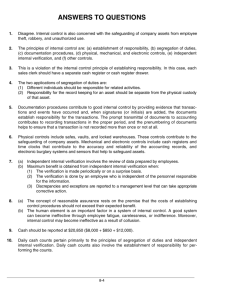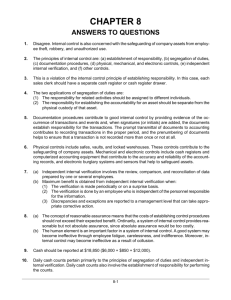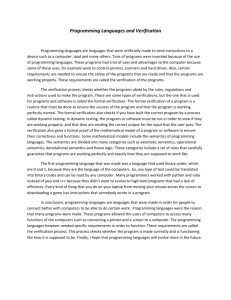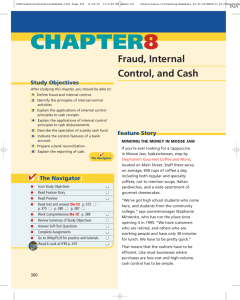from Chapter 8
advertisement
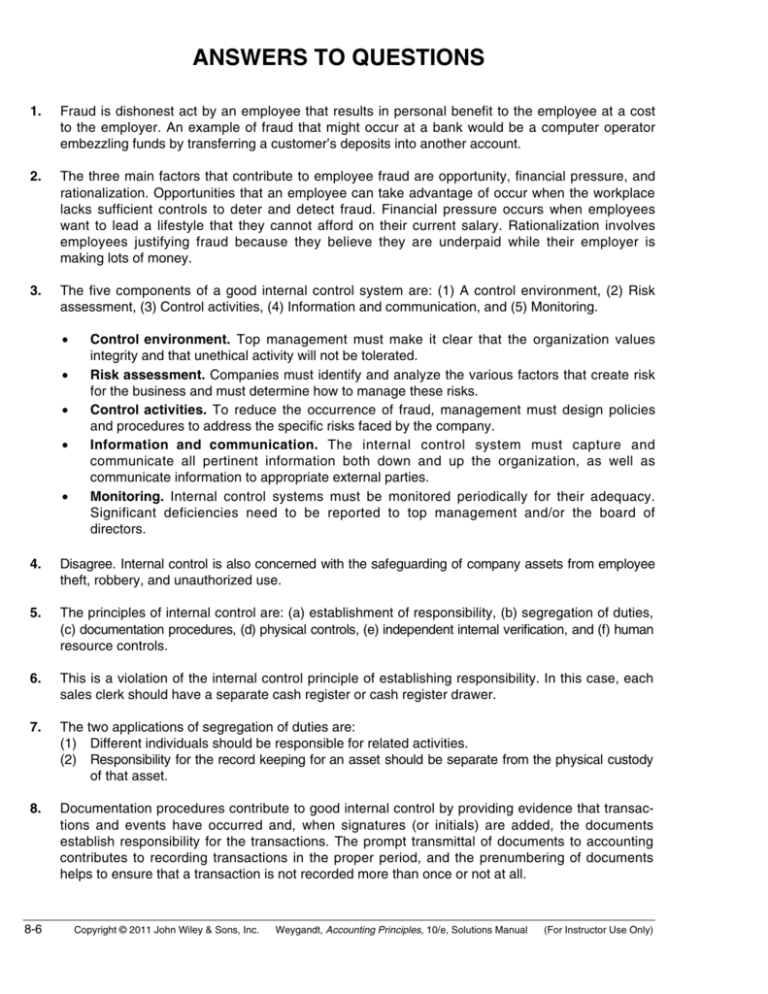
ANSWERS TO QUESTIONS 1. Fraud is dishonest act by an employee that results in personal benefit to the employee at a cost to the employer. An example of fraud that might occur at a bank would be a computer operator embezzling funds by transferring a customer’s deposits into another account. 2. The three main factors that contribute to employee fraud are opportunity, financial pressure, and rationalization. Opportunities that an employee can take advantage of occur when the workplace lacks sufficient controls to deter and detect fraud. Financial pressure occurs when employees want to lead a lifestyle that they cannot afford on their current salary. Rationalization involves employees justifying fraud because they believe they are underpaid while their employer is making lots of money. 3. The five components of a good internal control system are: (1) A control environment, (2) Risk assessment, (3) Control activities, (4) Information and communication, and (5) Monitoring. • • • • • Control environment. Top management must make it clear that the organization values integrity and that unethical activity will not be tolerated. Risk assessment. Companies must identify and analyze the various factors that create risk for the business and must determine how to manage these risks. Control activities. To reduce the occurrence of fraud, management must design policies and procedures to address the specific risks faced by the company. Information and communication. The internal control system must capture and communicate all pertinent information both down and up the organization, as well as communicate information to appropriate external parties. Monitoring. Internal control systems must be monitored periodically for their adequacy. Significant deficiencies need to be reported to top management and/or the board of directors. 4. Disagree. Internal control is also concerned with the safeguarding of company assets from employee theft, robbery, and unauthorized use. 5. The principles of internal control are: (a) establishment of responsibility, (b) segregation of duties, (c) documentation procedures, (d) physical controls, (e) independent internal verification, and (f) human resource controls. 6. This is a violation of the internal control principle of establishing responsibility. In this case, each sales clerk should have a separate cash register or cash register drawer. 7. The two applications of segregation of duties are: (1) Different individuals should be responsible for related activities. (2) Responsibility for the record keeping for an asset should be separate from the physical custody of that asset. 8. Documentation procedures contribute to good internal control by providing evidence that transactions and events have occurred and, when signatures (or initials) are added, the documents establish responsibility for the transactions. The prompt transmittal of documents to accounting contributes to recording transactions in the proper period, and the prenumbering of documents helps to ensure that a transaction is not recorded more than once or not at all. 8-6 Copyright © 2011 John Wiley & Sons, Inc. Weygandt, Accounting Principles, 10/e, Solutions Manual (For Instructor Use Only) Questions Chapter 8 (Continued) 9. Safes, vaults, and locked warehouses contribute to the safeguarding of company assets. Cash registers and time clocks contribute to the accuracy and reliability of the accounting records, and electronic burglary systems and sensors help to safeguard assets. 10. (a) Independent internal verification involves the review of data prepared by employees. (b) Maximum benefit is obtained from independent internal verification when: (1) The verification is made periodically or on a surprise basis. (2) The verification is done by an employee who is independent of the personnel responsible for the information. (3) Discrepancies and exceptions are reported to a management level that can take appropriate corrective action. 11. (a) The concept of reasonable assurance rests on the premise that the costs of establishing control procedures should not exceed their expected benefit. (b) The human element is an important factor in a system of internal control. A good system can become ineffective through employee fatigue, carelessness, or indifference. Moreover, internal control may become ineffective as a result of collusion. 12. Cash should be reported at $20,850 ($8,000 + $850 + $12,000). 13. Daily cash counts pertain primarily to the principles of segregation of duties, documentation procedures, and independent internal verification. Daily cash counts also involve the establishment of responsibility for performing the counts. 14. Cash registers are readily visible to the customer. Thus, they prevent the sales clerk from ringing up a lower amount and pocketing the difference. In addition, the customer receives an itemized receipt, and the cash register tape is locked into the register for further verification, providing documentation and enabling independent internal verification. 15. Two mail clerks contribute to a more accurate listing of mail receipts and to the endorsement of all checks “For Deposit Only.” In addition, two clerks reduce the likelihood of mail receipts being diverted to personal use. 16. Payment by check contributes to effective internal control over cash disbursements. However, effective control is also possible when small payments are made from petty cash. 17. The procedure and related principle are: Procedure Principle (1) (2) * Establishment of responsibility. * Physical controls. (3) 18. Treasurer signs checks. Checks imprinted by a machine in indelible ink. Comparing check with approved invoice before signing. * Independent internal verification. Physical controls apply to cash disbursements when: (a) blank checks are stored in a safe, and access to the safe is restricted to authorized personnel, and (b) a checkwriting machine and indelible ink are used to imprint amounts on checks. Documentation procedures apply when the company uses prenumbered checks and account for them in sequence, and stamps invoices “paid”. Copyright © 2011 John Wiley & Sons, Inc. Weygandt, Accounting Principles, 10/e, Solutions Manual (For Instructor Use Only) 8-7 Questions Chapter 8 (Continued) 19. (a) A voucher system is a network of approvals by authorized individuals acting independently to ensure that all disbursements by check are proper. (b) The internal control principles applicable to a voucher system are: (1) establishment of responsibility, (2) segregation of duties, (3) independent internal verification, and (4) documentation procedures. 20. Electronic funds transfer is a cash disbursement system that uses wire, telephone, or computers to transfer cash from one location to another. 21. The activities in a petty cash system and the related principles are: (a) (b) (1) (2) Establishing the fund. Making payments from the fund. (3) Replenishing the fund. * Establishment of responsibility for custody of fund. * Documentation procedures because the custodian must use a prenumbered petty cash receipt. * Independent internal verification because the request for replenishment must be approved before the check is written. Journal entries are required for a petty cash fund when it is established and replenished. Entries are also required when the size of the fund is increased or decreased. 22. Yes. A bank contributes significantly to internal control over cash because it: (1) safeguards cash on deposit, (2) minimizes the amount of currency that must be kept on hand, and (3) provides a double record of all bank transactions. 23. The lack of agreement between the balances may be due to either: (1) Time lags—a check written in July does not clear the bank until August. (2) Errors—a check for $110 is recorded by the depositor at $101. 24. The four steps are: (1) determine deposits in transit, (2) determine outstanding checks, (3) discover any errors made, and (4) trace bank memoranda. 25. (a) An NSF check occurs when the checkwriter’s bank balance is less than the amount of the check. (b) In a bank reconciliation, a customer’s NSF check is deducted from the balance per books. (c) An NSF check results in an adjusting entry in the company’s books, as a debit to Accounts Receivable and a credit to Cash. 26. (a) Yes. Cash equivalents are highly liquid investments that can be converted into a specific amount of cash with maturities of three months or less when purchased. Cash equivalents may be reported with cash in the current assets section of the balance sheet. (b) Cash restricted for a special purpose should be reported as a current or noncurrent asset depending on when the cash is expected to be used. 27. PepsiCo reports cash and cash equivalents of $3,943 million in its 2009 consolidated balance sheet. 8-8 Copyright © 2011 John Wiley & Sons, Inc. Weygandt, Accounting Principles, 10/e, Solutions Manual (For Instructor Use Only)
